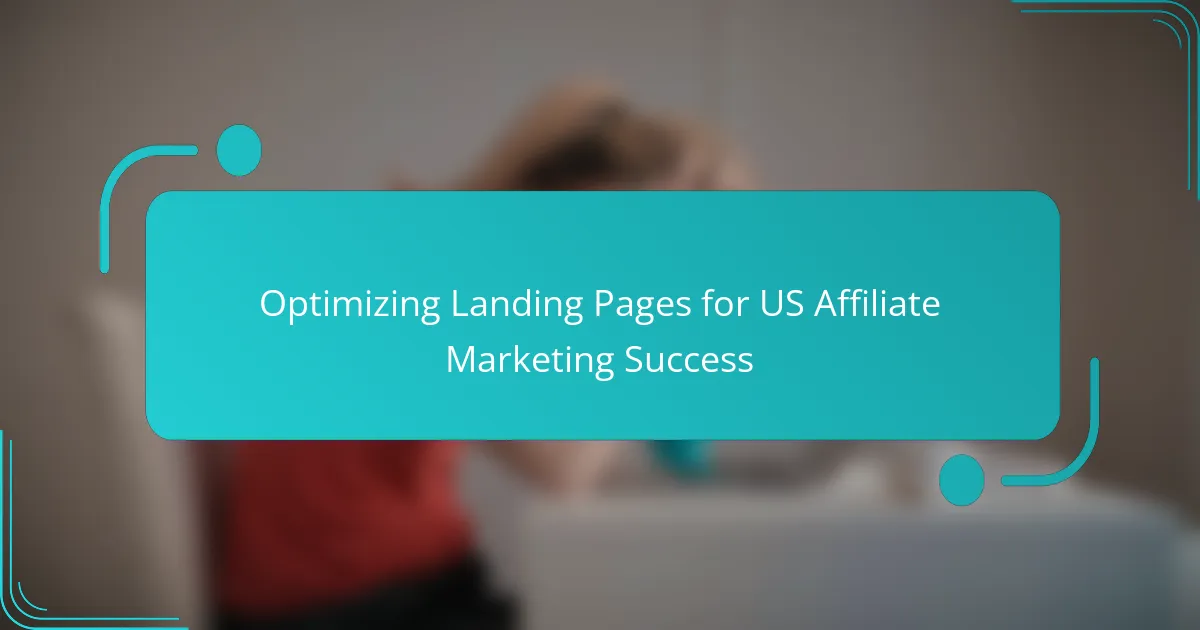Optimizing landing pages for US affiliate marketing is crucial for enhancing conversion rates and driving sales. By focusing on effective design, compelling content, and strategic testing, you can create a landing page that captures visitor attention and encourages action. Key elements such as clear call-to-action buttons and trust signals are essential for resonating with your target audience and improving overall performance.

How to Optimize Landing Pages for US Affiliate Marketing?
To optimize landing pages for US affiliate marketing, focus on enhancing conversion rates through effective design, testing, and content strategies. A well-structured landing page can significantly increase user engagement and drive sales.
Utilize high-converting templates
Selecting high-converting templates is essential for creating effective landing pages. These templates often include proven layouts, eye-catching visuals, and clear calls to action that guide visitors toward desired outcomes.
Consider using templates that are specifically designed for affiliate marketing, as they typically feature sections for product reviews, testimonials, and comparison tables. Tools like Unbounce or Leadpages offer a variety of customizable options to suit different niches.
Implement A/B testing strategies
A/B testing is crucial for determining which elements of your landing page perform best. By comparing two versions of a page, you can identify which headlines, images, or calls to action yield higher conversion rates.
Start by testing one element at a time, such as button color or text. Aim for a sample size that provides statistically significant results, usually in the low hundreds of visitors, to ensure your findings are reliable.
Incorporate SEO best practices
Integrating SEO best practices into your landing pages helps improve visibility on search engines, driving organic traffic. Focus on keyword research to identify terms that potential customers are searching for related to your affiliate products.
Optimize on-page elements like title tags, meta descriptions, and headers. Ensure your content is relevant and includes internal and external links to boost credibility and ranking potential.
Enhance user experience design
Improving user experience (UX) design is vital for keeping visitors engaged and reducing bounce rates. A clean, intuitive layout with easy navigation encourages users to explore your offerings.
Ensure your landing page loads quickly, ideally within a few seconds, and is mobile-friendly, as a significant portion of traffic comes from mobile devices. Use clear fonts and contrasting colors to enhance readability.
Leverage persuasive copywriting
Persuasive copywriting can significantly influence a visitor’s decision to convert. Use compelling headlines and benefit-driven language that resonates with your target audience’s needs and desires.
Incorporate social proof, such as testimonials or user reviews, to build trust. Highlight urgency with phrases like “limited time offer” or “only a few left in stock” to encourage immediate action.

What are the key elements of a successful landing page?
A successful landing page effectively captures visitor attention and drives conversions. Key elements include compelling headlines, clear call-to-action buttons, and trust signals such as testimonials, all tailored to resonate with the target audience.
Compelling headlines
Compelling headlines grab attention and convey the main benefit of your offer. They should be concise, engaging, and relevant to the visitor’s needs or pain points. Aim for headlines that evoke curiosity or urgency, such as “Unlock Your Potential Today!”
Consider using numbers or questions in your headlines to increase engagement. For example, “5 Ways to Boost Your Income with Affiliate Marketing” can attract clicks by promising specific insights.
Clear call-to-action buttons
Clear call-to-action (CTA) buttons guide visitors on what to do next. Use action-oriented language like “Get Started Now” or “Claim Your Free Trial” to encourage clicks. Ensure the button stands out visually, using contrasting colors and ample whitespace around it.
Position your CTA prominently on the page, ideally above the fold and repeated at strategic points. Test different placements and wording to find what resonates best with your audience.
Trust signals and testimonials
Trust signals and testimonials build credibility and reassure visitors about their decision to engage with your offer. Incorporate elements like customer reviews, ratings, and recognizable brand logos to enhance trustworthiness.
Display testimonials prominently, ideally with photos of the reviewers to add authenticity. Consider using a dedicated section for reviews or integrating them within the content to reinforce positive sentiments throughout the landing page.

How to measure landing page performance?
Measuring landing page performance involves analyzing key metrics that indicate how well the page converts visitors into customers. Focus on conversion rates, bounce rates, and user interactions to gain insights into effectiveness and areas for improvement.
Track conversion rates
Conversion rates represent the percentage of visitors who complete a desired action, such as making a purchase or signing up for a newsletter. To calculate this, divide the number of conversions by the total number of visitors and multiply by 100. Aim for a conversion rate of 2-5% for most affiliate marketing landing pages.
To improve conversion rates, consider A/B testing different elements like headlines, call-to-action buttons, and images. Small changes can lead to significant increases in conversions, so monitor performance regularly and adjust strategies accordingly.
Analyze bounce rates
Bounce rates indicate the percentage of visitors who leave the landing page without interacting. A high bounce rate, typically above 50%, suggests that the content may not be engaging or relevant. Use tools like Google Analytics to track this metric and identify pages that may need optimization.
To reduce bounce rates, ensure that your landing page loads quickly and provides clear, valuable information. Engaging visuals and concise copy can help retain visitors and encourage them to explore further.
Use heatmaps for user interaction
Heatmaps visually represent where users click, scroll, and spend time on your landing page. This data helps identify which elements attract attention and which areas may be ignored. Tools like Hotjar or Crazy Egg can provide these insights effectively.
By analyzing heatmaps, you can optimize your layout and content placement. For instance, if users frequently click on a specific button, consider making it more prominent or adjusting its position to enhance visibility and encourage conversions.

What tools can enhance landing page optimization?
Several tools can significantly improve landing page optimization for affiliate marketing in the US. Utilizing analytics, creation platforms, and testing software can lead to better performance and higher conversion rates.
Google Analytics for tracking
Google Analytics is essential for tracking user behavior on your landing pages. It provides insights into metrics such as page views, bounce rates, and conversion rates, allowing you to identify what works and what doesn’t.
To effectively use Google Analytics, set up goals that align with your marketing objectives. This will help you measure the success of your landing pages and make data-driven decisions for improvements.
Unbounce for landing page creation
Unbounce is a powerful tool designed for creating high-converting landing pages without needing extensive coding skills. It offers a drag-and-drop interface, allowing marketers to build pages quickly and efficiently.
When using Unbounce, focus on creating clear calls-to-action and optimizing for mobile devices. The platform also provides templates that are proven to convert, which can save time and enhance effectiveness.
Optimizely for A/B testing
Optimizely specializes in A/B testing, enabling you to compare different versions of your landing pages to see which performs better. This tool allows you to test various elements, such as headlines, images, and button colors.
To maximize the benefits of A/B testing with Optimizely, run tests for a sufficient duration to gather meaningful data. Aim for a sample size that provides statistical significance, typically in the hundreds or thousands, depending on your traffic levels.

What are common mistakes to avoid in landing page design?
Common mistakes in landing page design can significantly hinder conversion rates. Avoiding these pitfalls will enhance user experience and improve the effectiveness of your affiliate marketing efforts.
Overloading with information
Overloading a landing page with excessive information can overwhelm visitors and lead to decision paralysis. It’s crucial to present only the most relevant details that drive the user towards a specific action, such as signing up or making a purchase.
To keep your landing page focused, prioritize key messages and use bullet points for clarity. Aim for a concise layout that highlights benefits and calls-to-action without unnecessary distractions.
Poor mobile optimization
With a significant portion of web traffic coming from mobile devices, poor mobile optimization can severely limit your landing page’s effectiveness. Ensure that your page is responsive, meaning it adjusts seamlessly to different screen sizes and orientations.
Test your landing page on various mobile devices to identify any usability issues. Key aspects to check include load times, button sizes, and text readability. Aim for load times under three seconds and ensure that all interactive elements are easily accessible on smaller screens.
